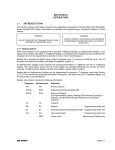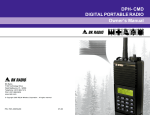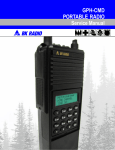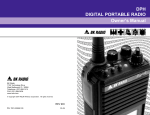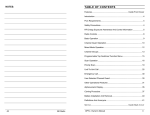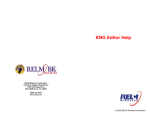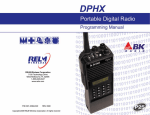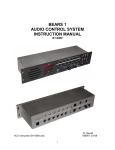Download BK Radio DPH- CMD Owner`s manual
Transcript
TABLE OF CONTENTS Features ............................................................... Inside Front Cover Introduction ..................................................................................... 4 FCC Requirements .......................................................................... 4 Safety Precautions ........................................................................... 4 RF Energy Exposure Awareness And Control Information .................. 5 Radio Controls................................................................................. 8 Basic Operation............................................................................... 9 Code Guard Operation ....................................................................10 Command Group ............................................................................11 Channel Groups .............................................................................13 Programmable Top Switches/ Function Menu...................................13 Scan Operation ..............................................................................14 Priority Scan...................................................................................17 User Transmit Code Guard..............................................................21 Other Operational Features .............................................................22 Alphanumeric Display .....................................................................25 Cloning Procedure ..........................................................................26 Battery Installation And Removal .....................................................29 Definitions And Acronyms ...............................................................31 Service................................................................... Inside Back Cover GPH-CMD Owner’s Manual 3 INTRODUCTION This manual contains information concerning the operation procedures for the BK Radio GPH-CMD radio. The GPH-CMD radio has been designed to meet the tough requirements of today’s communications environment. Please take a moment to read the information in this manual so you can get optimum performance from your new radio. FCC REQUIREM ENTS Your radio must be properly licensed by the Federal Communications Commission prior to use. Your BK Radio dealer can assist you in meeting these requirements. Your dealer will program each radio with your authorized frequencies, signaling codes, etc., and will be there to meet your communications needs as your system expands. SAFETY PRECAUTIONS • Do not operate the transmitter in close proximity to blasting caps. • Do not operate the radio in an explosive atmosphere (petroleum fuels, solvents, dust, etc.) unless your radio is an intrinsically safe model designed for such use. 4 BK Radio RF ENERGY EXPOSURE AWARENESS AND CONTROL INFORMATION, AND OPERATIONAL INSTRUCTIONS FOR FCC OCCUPATIONAL USE REQUIREMENTS NOTES: BEFORE USING YOUR PORTABLE 2-WAY RADIO, READ THIS IMPORTANT RF ENERGY AWARENESS AND CONTROL INFORMATION AND OPERATIONAL INSTRUCTIONS TO ENSURE COMPLIANCE WITH THE FCC’S RF EXPOSURE GUIDELINES. NOTICE: This radio is intended for use in occupational/controlled conditions, where users have full knowledge of their exposure and can exercise control over their exposure to meet FCC limits. This radio device is NOT authorized for general population, consumer, or any other use. This 2-way radio uses electromagnetic energy in the radio frequency (RF) spectrum to provide communications between two or more users over a distance. It uses radio frequency (RF) energy or radio waves to send and receive calls. RF energy is one form of electromagnetic energy; other forms include electric power, radar, sunlight and x-rays. RF energy, however, should not be confused with these other forms of electromagnetic energy, which when used improperly can cause biological damage. Very high levels of x-rays, for example, can damage tissues and genetic material. The energy levels associated with radio waves from portable 2-way radios, when properly used, are not great enough to cause biological damage. Experts in science, engineering, medicine, health and industry work with organizations to develop standards for exposure to RF energy. These standards provide recommended levels of RF exposure for both workers and the general public. These recommended RF exposure levels include substantial margins of protection. All 2-way radios marketed in North America are designed, manufactured and tested to ensure they meet government established RF exposure levels. In addition, manufacturers also recommend specific operating instructions to users of 2-way radios. These instructions are important because they inform users about RF energy exposure and provide simple procedures on how to control it. Please refer to the following WEBSITES for more information on what RF energy exposure is and how to control your exposure to assure compliance with established RF exposure limits. http://www.fcc.gov/oet/rfsafety/rf-faqs.html http://www.osha.gov/SLTC/radiofrequencyradiation/index.html 32 BK Radio GPH-CMD Owner’s Manual 5 FEDERAL COMMUNICATIONS COMMISSION REGULATIONS DEFINITIONS AND ACRONYMS The FCC rules require manufacturers to comply with the FCC RF energy exposure limits for portable 2-way radios before they can be marketed in the U.S. When 2-way radios are used as a consequence of employment, the FCC requires users to be fully aware of and able to control their exposure to meet occupational requirements. Exposure awareness can be facilitated by the use of a product label directing users to specific user awareness information. Your BK Radio 2-way radio has a RF exposure product label. Also, your BK Radio owner’s and service manuals include information and operating instructions required to control your RF exposure and to satisfy compliance requirements. COMPLIANCE WITH RF EXPOSURE STANDARDS Your BK Radio 2-way radio is designed and tested to comply with a number of national and international standards and guidelines (listed below) for human exposure to radio frequency electromagnetic energy. This radio complies with the IEEE and ICNIRP exposure limits for occupational/controlled RF exposure environment at operating duty factors of up to 50% transmitting and is authorized by the FCC for occupational use only. In terms of measuring RF energy for compliance with the FCC exposure guidelines, your radio radiates measurable RF energy only while it is transmitting (during talking), not when it is receiving (listening) or in Standby Mode. Note: The approved batteries supplied with this radio are rated for a 5-5-90 duty factor (5% talk-5% listen - 90% standby), even though this radio complies with the FCC occupational RF exposure limits and may operate at duty factors of up to 50% talk. Your BK Radio 2-way radio complies with the following RF energy exposure standards and guidelines: • United States Federal Communications Commission, Code of Federal Regulations; 47 CFR §§ 1.1307, 1.1310, 2.1091 and 2.1093 • American National Standards Institute (ANSI) / Institute of Electrical and Electronic Engineers (IEEE) C95. 1-1992 • Institute of Electrical and Electronic Engineers (IEEE) C95.11999 Edition ANI CG CLR Cloning Automatic Numeric Identification Code Guard Clear The process of copying data from one radio, called “master,” to other radios, called “slaves” or “clones.” Code Guard A sub-audible tone for selective calling and receiving. Command A group of up to 20 channels selected by the user Group from any of the 500 channels in the radio. Detent The click/hesitation you feel as you turn a knob from one position to another. DTMF Dual Tone Multiple Frequency DTMF Tones Tones that sound like those used by a standard push-button telephone. ENT Enter FCN Function Individual The information programmed with a PC on both a Personality global and by-channel basis that tells the radio exactly how to operate. LCD Liquid Crystal Display PROG Program PRI Priority PTT Push To Talk RTA Repeater Talk Around RTX Channel Ready to Transmit Channel RX Receive SCN Scan SQ Squelch Squelch A control that eliminates background noise. Talkback Scan When scanning, if a signal is present, the scan will stop and you will hear the signal. If you can then push the PTT switch to talk back to the person, you are in Talkback Scan Mode. Time-Out Timer A feature that limits the duration of calls. TX Transmit UTXG User Transmit Code Guard INDUSTRY CANADA COMPLIANCE This Class B digital apparatus complies with Canadian ICES-003. Cet appareil numerique de la classe B est conforme à la norme NMB-003 Canada. 6 BK Radio GPH-CMD Owner’s Manual 31 RF EXPOSURE COMPLIANCE AND CONTROL GUIDELINES AND OPERATING INSTRUCTIONS REMOVING THE BATTERY 1. Turn the radio off. 2. As shown above, push up the metal tab on the side of the case while twisting the battery pack approximately 30°. NOTE: All information programmed into the radio is maintained even when the battery pack is removed. 3. Remove battery pack from the radio. NOTE: Periodically check the contacts on the battery pack for dirt that could prevent a good electrical contact with the charging base. WARNING: EXPLOSION HAZARD Do not drop a battery pack into fire. An explosion may occur. ANTENNA INSTALLATION 1. Insert the flexible helical-wound antenna into the radio's antenna connector and turn it clockwise until it is firmly seated. To control your exposure and ensure compliance with the occupational/controlled environment exposure limits always adhere to the following procedures. Guidelines: • Do not remove the RF Exposure Label from the device. • User awareness instructions must accompany device when transferred to other users. • Do not use this device if the operational requirements described herein are not met. Operating Instructions: • Transmit no more than the rated duty factor of 50% of the time. To transmit (talk), push the Push-To-Talk (PTT) button. To receive calls, release the PTT button. Transmitting 50% of the time, or less, is important because this radio generates measurable RF energy exposure only when transmitting (in terms of measuring for standards compliance). • Hold the radio in a vertical position in front of face with the microphone (and the other parts of the radio, including the antenna) at least one inch (2.5 cm) away from the nose. Keeping the radio at the proper distance is important because RF exposures decrease with distance from the antenna. Antenna should be kept away from eyes. • When worn on the body, always place the radio in a BK Radio approved clip, holder, holster, case, or body harness for this product. Using approved body-worn accessories is important because the use of BK Radio or other manufacturer’s non-approved accessories may result in exposure levels which exceed the FCC’s occupational/controlled environment RF exposure limits. • If you are not using a body-worn accessory and are not using the radio in the intended use position in front of the face, then ensure the antenna and the radio are kept at least one inch (2.5 cm) from the body when transmitting. Keeping the radio at the proper distance is important because RF exposures decrease with increasing distance from the antenna. • Use only BK Radio approved supplied or replacement antennas, batteries, and accessories. Use of non-BK Radio approved antennas, batteries, and accessories may exceed the FCC RF exposure guidelines. • For a list of BK Radio approved accessories visit the following website : http://www.relm.com . CONTACT INFORMATION For additional information on exposure requirements information, visit website http://www.relm.com. 30 BK Radio GPH-CMD Owner’s Manual or other 7 • RADIO CONTROLS TRANSMIT INDICATOR BK RADIO CODE GUARD SQUELCH SQUELCH CODE GUARD ANTENNA ON/OFF VOLUME CG - SQ GPH-CMD WITH DPH RADIO RADIO WITH KEYPAD/DISPLAY KEYBOARD/DISPLAY COVERED COVERED OR (REDUCED VIEW) NOT INSTALLED (REDUCED VIEW) HI/LO TRANSMIT HI/LO POWER A B OFF-VOL 8 9 10 7 6 11 5 12 4 13 3 14 2 1 16 15 C SCAN 11. If the download was not successful, the master will flash ‘FAILURE’ and multiple beeps will follow. Failure of downloading can be due to: FAILURE Group 01 CHANNEL SELECT PRIORITY INDICATOR BUSY CHANNEL LOW BATTERY PRIORITY BK RADIO ANTENNA If cloning is finished, turn off the Clone and disconnect the cloning cable. Normal radio operation will occur when you turn on the Clone. 1 2 3 FCN 4 5 6 PRI 7 8 9 ENT * 0 # CLR • Improper connection • Failure to turn on the clone • Setting the clone in Programming Mode • Target radio’s group ‘locked’ by PC Programming NOTE: SPEAKER ACCESSORY MOUNT MICROPHONE To stop the ‘FAILURE’ Mode, press [CLR], turn off both radios, and try again, starting with Step 1 on the previous page. PROG TX RX SCN I D CG CMND EARPHONE PRG TX RX SCN ID CG home channel Tone 32 G R P PTT (PUSH TO TALK) 1 2 3 FCN 4 5 6 PRI 7 8 9 ENT * 0 # CLR LCD DISPLAY BATTERY INSTALLATION AND REMOVAL KEYBOARD BK Radio battery packs are available in a variety of sizes and types for special applications. Rechargeable battery packs can be charged separately or while attached to a radio. NOTE: For safety reasons, rechargeable battery packs are shipped uncharged or only partially charged. Therefore, a rechargeable battery pack should be properly charged before use. INSTALLING THE BATTERY 1. Locate the center hub on the radio base and place it in the recess of the battery pack. 2. Position the battery pack at the 30° offset, seating the two metal studs in their recess. 3. Apply upward pressure to the pack while twisting the pack to its final (in line with the radio) position. The metal tab will click, locking the pack in position. PROG TX RX SCN ID CG CMND home channel Tone 32 Alphanumeric Display 8 BK Radio GPH-CMD Owner’s Manual 29 7. PROG|GPHcmD Group 01 Press and Hold [*] Key to Change Target PROG|GPH Group 01 Press the [*] key on the Master radio keypad. The radio will respond showing the prompt ‘P ROG|GPHCMD’ on the first line and ‘Group XX’ on the second line, where XX is the currently selected group (see Select A Group/Channel, page 13, for details of how the group is selected). 8. Valid Target GPH-CMD only GPH-CMD, GPH GPH-CMD, GPH GPH-CMD only Target Valid Data GROUP 00 or GROUP 01 - 25 GPHCMD CMND GRP PICK LIST PROG|GPHcmD pick list GPH 9. GROUP 01 - 25 CMND GRP Once the target and data to be transferred have been selected, press the [FCN] key on the Master radio keypad. The top line of the display will flash ‘CLONING’ while the program in the master is being downloaded to the clone. 10. If the download was successful, the display on the Master will again display the clone prompt (target and data to be transferred). • 28 1. Turn power on by turning the Volume knob clockwise. A beep sounds, indicating the radio is operational. The LCD display shows the current channel. 2. Select a channel by rotating the Channel Selector knob. When the unstopped channel th selector is rotated past the highest (20 ) channel, the radio will emit a beep and remain on the highest channel. When st rotated past the lowest (1 ) channel, the radio will emit a beep and remain on the lowest channel. 3. Adjust squelch and volume by turning the Squelch knob clockwise until you hear noise. Set the volume to a comfortable level. Then turn the Squelch knob counterclockwise until the noise stops. This is called the Threshold Squelch setting. Long [#] keypresses will cause the second line of the display to cycle through the data blocks that can be transferred to the target displayed on the first line. Press and Hold [#] Key to Change Data CLONING Group 01 RECEIVE Long [*] keypresses will toggle the first line of the display between ‘P ROG|GPHCMD’ and ‘PROG|GPH’, if the second line of the display shows data that is valid to copy to the displayed target. Data GROUP 00 GROUP 01 - 25 CMND GRP PICK LIST PROG|GPHcmD Cmnd group BASIC OPERATION Turning the Squelch knob fully counterclockwise past the detent places the receiver in Code Guard. A message will be heard only when the proper Code Guard value is received. TRANSMIT 1. 1. Press the PTT (Push-To-Talk) switch. When the transmitter is on, the red Transmit Indicator glows and TX appears in the display. 2. Talk in a normal voice with the microphone one to two inches from your mouth. 3. Release the PTT switch to stop transmitting. PTT Microphone To clone another channel group, press the Master radio’s [CLR] key. Navigate to a ‘CH’ prompt, then press and hold the [#] key to get the ‘GRP’ prompt. BK Radio GPH-CMD Owner’s Manual 9 If the Transmit Indicator does not glow when you press the PTT switch, the battery pack may need to be charged. If so, the display will indicate LOBATT, and the yellow Low-Battery Indicator will flash. If the Transmit Indicator does not glow and a tone sounds, you are on a receive-only channel or the channel is busy (if Busy Channel lockout is enabled). Select an authorized transmit channel. If the length of your message exceeds the preset Time-Out Timer setting, the transmitter automatically shuts off and a tone sounds. To continue transmission, release the PTT switch, and then press it again and continue talking. CODE GUARD OPERATION Code Guard™ allows one radio or a group of radios to be selectively called within a system. If the radio has been programmed with Code Guard, use the following receive and transmit instructions. CODE GUARD RECEIVE Data that can be cloned to a standard GPH radio includes: • Group data • Command Group data When cloning to a GPH radio, the Master’s global data is converted to group data in the slave, and only the first 16 channels are transferred. When receiving an incoming clone from a GPH radio, the GPH-CMD radio ignores group data other than the group label and the group scan list bit. The GPH-CMD’s global data is not disturbed. NOTE: Some groups may be “locked” by PC programming to prevent them from being overwritten. Only “unlocked” groups will accept incoming clones. Master 1. Turn power on by turning the Volume knob clockwise. 2. Select a Code Guard channel by turning the Channel Selector knob. 3. Adjust volume by turning the Squelch knob clockwise until a noise is heard. Set the volume to a comfortable level. 4. CMND CLN Set Code Guard Mode by turning the Squelch knob off (counterclockwise) into the Code Guard position. A message will be heard only when the proper Code Guard value is received. When the Master’s Command Group is cloned to a slave, the channel data that is ‘pointed to’ by the Command Group is transferred to a target group (not the Command Group) in the slave. The target group’s label in the slave will be set to ‘CMND CLN’. 1. Make sure the battery packs for both radios are charged. 2. Attach the master switch end of the cloning cable to the side connector of the Master radio. Clone NOTE: Master Switch 3. Turn on the Master radio. 4. Put the Master radio in Programming Mode by pressing and holding the master switch then pressing and holding the [FCN] key until the display shows ‘PSWRD-******’. Enter the password of the selected group. The display shows ‘PROG CH 00.’ 5. Connect the other plug of the cable to the side connector of the radio you want to clone. 6. Turn on the clone and set it to the desired channel group. PSWRD-****** PROG ch 10 BK Radio 00 One plug of the cloning cable has a push-button master switch. This plug must be attached to the Master radio. GPH-CMD Owner’s Manual 27 GPH-CMD Series portable radios can be programmed with the following features: CODE GUARD TRANSMIT 1. DISPLAY BACKLIGHTING The GPH-CMD radios can be programmed by your dealer to backlight the display when a signal is received or when a key is pressed. The time duration of the backlighting can also be programmed. NOTE: Busy Channel Indicator The radio can be programmed with a label for each of the 25 channel groups and a label for each of the 20 channels within each group. To display a group label, turn scanning functions off, then: 2 3 FCN 4 5 6 PRI 7 8 9 ENT * 0 # CLR 1. Press the [#] key on the keypad to display the group number. 2. Press and hold the [#] key to display the group label. 3. Press the [ENT] key or wait for about 5 seconds to revert to normal radio operation. CLONING PROCEDURE Press the PTT switch. When the transmitter is on, the red Transmit Indicator glows and TX appears in the display. 3. If monitoring the channel, reset the squelch knob to the Code Guard position to receive only the messages with the proper Code Guard value. During extended transmissions, the squelch can be left open until the exchange has ended. Data that can be cloned to another GPH-CMD radio includes: 26 Group data • Command Group data • Global data • UTXG Pick List Code Guard is a trademark of BK Radio, Inc. COMMAND GROUP The GPH-CMD radio allows construction of a Command Group of up to 20 channels, drawn from any of the programmed channels in the radio. To modify the Command Group (add or delete channels) all scanning functions (Channel Scan, Group Scan, and Priority Scan) must be turned OFF. BUILDING A COMMAND GROUP Any “Master” radio (a GPH-CMD with the desired radio frequencies and settings) is capable of transferring its program to another GPHCMD or GPH radio. The radio receiving the program is referred to as the “Slave” or “Clone.” The LAA0700 cloning cable will be required in the following procedure. • Do not transmit if the channel is busy. 2. CHANNEL AND GROUP LABELS 1 Turn the Squelch knob on (clockwise) and monitor the Code Guard channel before transmitting, or, if Busy Channel operation is enabled, check the yellow LED. 1 2 3 FCN 4 5 6 PRI 7 8 9 ENT * 0 # CLR CMND CHAN 5 BK Radio While operating in a group other than the Command Group (group 1 – 25), the user selects a channel in the radio and presses the [*] key to enter the channel into the Command Group. If a channel is on the scan list in its home group, it will also be on the Command Group’s scan list. Unprogrammed channels cannot be added to the Command Group. Up to 20 channels may be entered. After adding a channel, the display momentarily shows ‘CMND CHAN XX’ where XX is the channel number (1 – 20). Parameters associated with each selected channel, such as Bandwidth, Scan, and Power settings, are also used while operating in the Command Group. GPH-CMD Owner’s Manual 11 Once 20 channels are entered, subsequent presses of the [*] key will cause the radio to beep and momentarily display the message ‘CMND FULL’. When operating in the Command Group, the continuously rotating channel selector will “stop” at the highest programmed channel. For example, if only 4 channels are programmed, when the channel th selector is rotated past the 4 channel the th radio will beep and remain on the 4 channel. CMND full 2 3 FCN 4 5 6 PRI 7 8 9 ENT * 0 # CLR SCN CMND LABEL 7 This mode operates in the same manner as Busy Channel Lockout except that the user can override and transmit by turning the Squelch knob off the Code Guard detent. The transmitter is locked out only if the Squelch knob is set to the Code Guard detent. ALPHANUMERIC DISPLAY OPERATING FROM THE COMMAND GROUP 1 BUSY CHANNEL LOCKOUT WITH OVERRIDE The Command Group can be entered by pressing the [#] key twice. Operation in the Command Group is indicated on the display by the ‘CMND’ icon. GPH-CMD radios may optionally have a slideout keypad/display cover. To remove or install the cover, turn off the radio and remove the battery (see Battery Installation and Removal, page 29). Adding or deleting a channel to/from the Command Group’s scan list also changes the channel’s status in its home group. Display annunciators indicate the following information: It is not valid for a priority channel to be set to a channel in the Command Group. If, while operating in the Command Group, the [PRI] key is pressed to designate a priority channel, the “target channel” that is pointed to by the Command Group channel will be marked as the priority channel. ALPHANUMERIC PR PROG TX RX SCN MODIFICATION OF THE COMMAND GROUP 1 2 3 FCN 4 5 6 PRI 7 8 9 ENT * 0 # CLR CMND Chan deleted CMND cmnd empty When the Command Group is active, a short press of the [*] key deletes the knob-selected channel, while a long press (4 seconds) deletes all channels in the Command Group. CG CMND When a channel is deleted, the display momentarily shows ‘CHAN DELETED’, and the following channels move up in the list. For example, if channel 5 is deleted, channel 6 becomes the new channel 5, channel 7 becomes the new channel 6, etc. When all channels are deleted, the radio beeps continuously and the display shows C ‘ MND EMPTY’ along with the ‘CMND’ icon. Exit the Command channels. 12 ID Group to add INDICATION -Priority Channel -Programming Mode -Transmit -Receive -Scan List Channel -Flashing SCN indicates scanning in progress and RX SCN indicates receiving on a scanned channel. -Programming Mode – Automatic Numeric Identification (ANI) -Programming Mode – Code Guard -Command Group Active PROG TX RX SCN ID CG CMND home channel Tone 32 Alphanumeric Display new BK Radio GPH-CMD Owner’s Manual 25 BUSY CHANNEL INDICATION CHANNEL GROUPS The yellow Busy Channel Indicator glows if there is carrier activity on the selected channel. If the selected channel is a Code Guard channel and the proper Code Guard value is not detected, the Busy Channel Indicator remains on for the duration of the carrier activity and no message is heard. During Scan and Priority Scan operation, the Busy Channel Indicator glows when activity is detected on any channel on the Scan List. When scanning or priority scanning Code Guard channels with the Squelch knob in the Code Guard position and activity has been detected, the Busy Channel Indicator glows for the time period necessary to determine if the proper Code Guard value has been received. This will cause the Busy Channel Indicator to flash at various rates. Channels are arranged in 25 groups of up to 20 channels. SELECT A GROUP/CHANNEL 1 2 3 FCN The rotary knob selects channels in the group selected by the keypad: 4 5 6 PRI 1. Press the [#] key on the keypad to display the current group number. 7 8 9 ENT 2. * 0 # CLR Press number keys for the new group number, or press [#] again to select the Command Group. When changing groups, invalid entries will not be accepted, and the radio remains in the previously selected group. 3. Press the [ENT] key or wait 5 seconds. The radio returns to normal operation for the new group, and the selected channel is displayed. All selected scanning functions affect only the channels in the group you are operating in. BUSY CHANNEL LOCKOUT The Busy Channel Lockout feature applies only to those channels programmed with a receive Code Guard value. When carrier activity is detected on the channel selected, the radio checks the receive Code Guard value. If the proper Code Guard value is present, the radio can transmit on that channel, even if the Squelch knob is in the Code Guard position. BUSY If the radio detects an incorrect value or carrier activity only, the transmitter is disabled. If an attempt is made to transmit, an alert tone will be generated and the display will show the word BUSY until the channel becomes available or the PTT switch is released, whether the Squelch knob is in or out of the Code Guard detent. Channels not programmed with a receive Code Guard value can be used to transmit regardless of carrier activity. 24 BK Radio PROGRAMMABLE TOP SWITCHES / FUNCTION MENU The following functions can be assigned to the three top switches or the keypad [FCN] key menu: FUNCTION FCN Key Menu Label Low Power Select TX LOW POWER Channel Scan CHANNEL SCAN Priority Scan PRI SCAN Repeater Talk Around TALK-AROUND Group Scan GROUP SCAN Scan HI/LO Priority Scan GPH-CMD Owner’s Manual 13 Your dealer can also assign more than one function to the same top switch. For example, both low-power select and RTA could be enabled by the same switch. NOTE: 1 2 3 FCN 4 5 6 PRI 7 8 9 ENT * 0 # CLR Assume for this manual that Switch ‘A’ has been programmed for HI/LO Transmit Power, Switch ‘B’ has been programmed for Scan, and Switch ‘C’ has been programmed for Priority Scan. 1 2 3 FCN 4 5 6 PRI 7 8 9 ENT * 0 # CLR 1. Press the [FCN] key to display the function menu. 2. Repeatedly press [FCN] to step through the menu. Press [PRI] to toggle the function on/off when the desired menu item is displayed. When the display flashes, the function is enabled. KEYPAD LOCK To lock/unlock the keypad, press and hold the [FCN] key. When locked, “LOCKED” will be displayed if a key is pressed and a low beep will sound. 1 2 3 FCN 4 5 6 PRI 7 8 9 ENT * 0 # CLR 14 3 Press any of the keys on the keypad. ANI encoding (Automatic Numeric Identification), if enabled, transmits a sequence of DTMF tones each time you press the PTT switch. You will hear a sidetone. Your dealer can program the ANI number to be sent. If DTMF and ANI are both enabled, the ANI tone sequence is transmitted only after the [ENT] key is pressed while the PTT switch is activated. You will hear a sidetone. The transmit Time-Out Timer limits the duration of calls and guards against accidentally locking on the transmitter and tying up the radio system. Your dealer can program the duration of the Time-Out Timer (15-225 seconds, or disabled). BUSY CHANNEL The display indicates scan operation by flashing SCN. SCN LABEL Slide Switch C (priority) down. 2. TIME-OUT TIMER SCAN OPERATION 2. Press and hold the PTT switch. ANI ENCODING PTT unlocks the keypad during transmit for enabled DTMF key presses. Slide Switch B (scan) up. 1. The FCN, PRI, ENT, and CLR keys respond as DTMF tones A, B, C, and D, respectively. LOCKOUT EXCEPTIONS: 1. Radios can be programmed to enable DTMF (Dual Tone Multiple Frequency) encoding. To send DTMF tones (similar to the tones used by a standard push-button telephone): You will hear a sidetone. To access functions on the keypad [FCN] key menu: 3. LOCKED DTMF ENCODING Scan operates only while the radio is not transmitting. The radio checks for signals on channels in the preset Scan List, as well as BK Radio If the radio has been programmed for Busy Channel operation, it will operate in one of the following three Modes: • Busy Channel Indication • Busy Channel Lockout • Busy Channel Lockout with Override GPH-CMD Owner’s Manual 23 Programming of the list (if programming is not locked out by PC software) can be accomplished as follows: the channel selected by the Channel Selector knob. RX SCN 1. While viewing the list, press and hold the [FCN] key until the ‘PROG’ annunciator lights. 2. Press [CLR] and then enter the new CxCSS. Press [ENT] to store the new value and return to the list viewer. LABEL 6 When a signal is detected, scanning stops and the message is received. The received channel is shown in place of the transmit channel. Once the signal ends, the radio continues to monitor the channel for the preset scan delay time before it resumes scanning. SCAN CODE GUARD CHANNELS OTHER OPERATIONAL FEATURES 1. Slide Switch B (scan) up. The BK Radio GPH-CMD Series is based on a microprocessor core that allows extra features and operational characteristics to be programmed into the radio. Your dealer can help define the best operational settings for your system and program them into the radio. SCAN DELAY Scan delay lets the radio receive a response to a transmission before scanning the other channels for activity. If you find that your scanner is restarting before message replies are received, you can ask your dealer to increase the scan delay time (0-7.5 seconds). This timer is also used to allow for Talkback Scan. HI/LO POWER Each channel in the radio can be individually programmed to always transmit in Low-Power Mode, regardless of the position of the radio's top switch (or keypad [FCN] menu setting). If the programming for the channel allows highpower transmissions, the power level can be selected with a top switch or the keypad menu. 22 BK Radio 2. Turn the S quelch knob completely counterclockwise, past the detent, to the Code Guard position. When a signal is detected, scanning stops while the radio checks for the proper Code Guard value. If the signal contains the proper Code Guard value, the radio receives the message. Otherwise, the radio resumes scanning immediately. NUISANCE CHANNEL DELETE If your radio is programmed for Nuisance Channel Delete and Channel Scan is assigned to a top switch (Switch B, for example), a Nuisance Channel can be temporarily removed from the Scan List by sliding Switch B down and then back up. TRANSMIT WITH SCAN ON When Switch B (scan) is up, the radio transmits on the channel selected by the Channel Selector knob unless Talkback Scan is enabled or “Transmit on Priority-1” is enabled (see Priority Scan operation). 1. Select a transmit channel by turning the Channel Selector knob. 2. Press and hold the PTT switch and talk in a normal voice. GPH-CMD Owner’s Manual 15 When the PTT switch is released, the radio continues to monitor the selected channel for the preset scan delay time before it resumes scanning. TALKBACK SCAN NOTE: If the radio is programmed for Dual Priority operation, only the Priority 1 channel can be changed with the [PRI] key. NOTE: A channel can be the priority channel even if it is on the Scan List. Due to multiple sampling of the same channel, however, maximum performance occurs when the priority channels are not on the Scan List. If your radio is programmed for Talkback Scan, press PTT while a channel is active or while scan delay time remains. You will be responding on the transmit frequency of the received channel. Talkback Scan will not work if Priority Scan is also on and your radio is programmed to always transmit on the Priority 1 channel. CHANGE THE SCAN LIST If the radio has not been programmed for Scan List Lock, the user may add or remove channels from the Scan List. If user changes are enabled, follow these steps to change the Scan List: SCN 1. Slide Switches B (scan) and C (priority) down. 2. Select a channel to be added or removed from the Scan List by turning the Channel Selector knob. If the channel is already on the Scan List, SCN appears in the display. 3. Press the [ENT] key to add a channel to the Scan List. A short beep sounds and SCN appears in the display. 4. Press the [CLR] key to remove a channel from the Scan List. A short beep sounds and SCN disappears from the display. LABEL 12 1 2 3 FCN 4 5 6 PRI 7 8 9 ENT * 0 # CLR USER TRANSMIT CODE GUARD When the radio is being programmed with transmit and receive frequencies for each channel, a receive Code Guard value and a transmit Code Guard value can also be assigned to each channel. On channels that do not have a default transmit Code Guard programmed, the user can choose CxCSSs from a global UTXG Pick List containing 32 entries. To assign a UTXG for use on a channel, all scanning functions (Channel Scan, Group Scan, and Priority Scan) must be turned OFF. The user selects a channel and then uses the keypad to enter a number from 1 to 32. When UTXG is active, the second line of the display will show the number of the selected list entry (TONE – XX). Once a UTXG is assigned to a particular channel, it will be stored and used with that channel whenever the channel is selected. Repeater Talk Around operation will use the pre-programmed RX CxCSS. LABEL 20 TONE 8 The UTXG Pick List can be viewed by pressing [FCN] [1]. The display will show: TONE - 01 000.00 TONE – 01 XXX.X GROUP SCAN Channels on each “Channel Scan List” in groups on the “Group Scan List” are scanned sequentially. The selected group is always scanned when Group Scan is enabled, even if that group is not on the Group Scan List. 16 BK Radio 1 2 3 FCN 4 5 6 PRI 7 8 9 ENT * 0 # CLR or TONE – 01 DXXX Press [PRI] to increment through the list or key in a number. Press [ENT] to exit the list viewer. (This feature is for viewing the list only. Pressing [ENT] when a list item is displayed does NOT associate the UTXG with the selected channel.) GPH-CMD Owner’s Manual 21 To reply to a message on the priority channel, press the PTT switch. The radio transmits only on the priority channel when Switch C (priority) is up. Once activity has ceased on the priority channel, the radio returns to the receive channel on the Channel Selector knob. PRIORITY SCAN Priority Scan enables the radio to receive on any channel while monitoring for a message on the designated priority channel(s). The radio samples each priority channel at a preset rate (.25-2.0 seconds) regardless of activity on any other channel. Priority Scan operates only while the radio is not transmitting and can be used in combination with scan operation. Priority Mode C with Scan With Switches B (scan) and C (priority) up, the radio scans until it locks on to an active channel. The radio continues to sample the priority channel while listening to the active channel. If activity occurs on the priority channel, the radio overrides the active scan channel, changes to the priority channel, and holds for the duration of the transmission. To reply to a message on the priority channel, press the PTT switch. The radio transmits only on the priority channel when Switch C (priority) is up. Once activity has ceased on the priority channel, the radio returns to scan operation. SCN LABEL PR LABEL 3 SCN 8 When Switch C (P riority) is up, the display flashes SCN. If a message is received on a priority channel, the Priority Indicator lights, and the radio receiver locks onto that channel for the duration of the transmission, unless a higher priority channel interrupts. Priority Scan can be used in combination with Code Guard with: • Switch C (Priority) up • The Squelch knob in the Code Guard position (fully counterclockwise detent position) and • The Priority Channel(s) programmed with Code Guard CHANGE THE PRIORITY 1 CHANNEL The fixed Priority 1 channel can be permanently set or can be changeable. If the radio has a changeable priority channel, use the following steps to make this change: 1 2 3 FCN 4 5 6 PRI 7 8 9 ENT * 0 # CLR 1. Slide Switches B (scan) and C (priority) down. 2. Use the keypad to change groups, if necessary. Turn the Channel Selector knob to the channel you want to enter as the new Priority 1 channel. 3. Press the [PRI] key. A short beep sounds and PR appears in the display, indicating that the displayed channel is now the Priority 1 channel. PR LABEL 20 3 BK Radio If a message is received on a priority channel, the radio receiver locks on to the priority channel and checks to see if the proper Code Guard value is present. If the signal contains the proper Code Guard value, the radio receives the message. Otherwise, the radio will re-check the channel every 4 seconds, until the activity on the channel ceases. DUAL PRIORITY SCAN Up to two of the radio’s 500 channels can be designated as priority channels. These two, PR1 and PR2, are periodically tested for activity, even if a different transmission is being listened to. Activity on PR2 preempts activity on any of the non-priority channels. Receptions on PR1 have priority over any other channel, including PR2. GPH-CMD Owner’s Manual 17 Either priority channel can be programmed as a fixed channel, tied to the Channel Selector knob, or programmed OFF. If the radio is programmed to transmit on the first priority channel, transmissions will occur on PR1 when operating in Priority Scan Mode. PR RX SCN LABEL 3 To reply to a message on the priority channel, press the PTT switch and the radio will transmit on the priority channel. Once activity ceases on the priority channel, the radio returns to scan operation. Priority Mode B If PR1 is a fixed channel, and the [PRI] key is not locked out, the user can use the keypad to change groups, if necessary, move the channel selector to a new channel and press the [PRI] key to choose a new PR1 channel. With Switch C (priority) up and Switch B (scan) down, the radio can receive on the knob-selected channel while sampling the priority channel. If the priority channel becomes active, the Priority Indicator lights up. The radio changes to the priority channel and holds for the duration of the transmission. OLD-STYLE BK PRIORITY SCAN The radio can be programmed with one of three Priority Modes: A, B, or C. The table below shows how the priority channels and the transmit channels are selected in each mode. To reply to a message on the priority channel, use the keypad to change groups if necessary, turn the Channel Knob to select the priority channel, and then transmit. Priority Mode B with Scan Mode A Mode B Mode C Priority Channel Channel Knob Preset Preset Transmit Channel Channel Knob Channel Knob Priority Channel With Switches B (scan) and C (priority) up, the radio scans until it locks on to an active channel. The radio continues to sample the priority channel while listening to the active scan channel. If activity occurs on the priority channel, the radio overrides the active scan channel, changes to the priority channel, and holds for the duration of the transmission. Priority Mode A With Scan In Priority Mode A, the priority channel is set by the Channel Selector knob. Priority Mode A is seldom used by itself because the radio receives and transmits only on the knobselected channel. RX SCN LABEL 12 When Switches B (scan) and C (priority) are up, scanning occurs until an active scan channel is found. The radio receives the message while continuing to check the priority channel. The display shows the scan channel. If the priority channel becomes active during this message, the Priority Indicator will light. The radio changes to the priority channel and holds for the duration of the message. The display shows the priority channel. 18 BK Radio To reply to a message on the priority channel, use the keypad to change groups if necessary, turn the Channel K nob to select the priority channel, and then transmit. Once activity has ceased on the priority channel, the radio returns to scan operation. Priority Mode C With Switch C (priority) up and Switch B (scan) down, the radio samples the fixed priority channel at the preset rate. If activity occurs on the priority channel, the radio changes to the priority channel and holds for the duration of the transmission. GPH-CMD Owner’s Manual 19
















